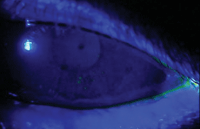 Q:
I have recently seen several patients with filamentary keratitis (FK). In general, they are difficult to manage because of their refractory state. Would contact lenses be therapeutic? Are there any new treatment options?
Q:
I have recently seen several patients with filamentary keratitis (FK). In general, they are difficult to manage because of their refractory state. Would contact lenses be therapeutic? Are there any new treatment options?
A: FK can be a chronic, persistent and devastating condition, but if you are diligent with diagnosis and management, you can limit the number and severity of recurrences.1 “The key to treating filamentary keratitis is to address the underlying condition that causes the corneal filaments to form,” says Craig Thomas, O.D., a private practitioner at First Eye Care in Dallas.
For moderate to severe FK, current best practices include the use of multiple eye drops and bandage contact lenses. “Bandage contact lenses protect the damaged epithelium from the shearing effects of the eyelids; this allows the damaged basal cells of the epithelium to attach to Bowman’s membrane,” Dr. Thomas says. “Smooth attachment of the basal epithelial cells to Bowman’s membrane prevents the formation of new receptor sites for the corneal filaments.”

|
| If untreated, the focal epithelial defects (seen above) stained with fluorescein dye, will serve as attachment points for corneal filaments. Photo: Craig Thomas, O.D.
|
Topical pharmacologic treatment options include artificial tears, steroids, immunomodulators and 5% hypertonic solution. Preservative-free artificial tears lubricate the cornea and relieve ocular discomfort, while steroids can modify or reduce the number of mucus receptor sites by inhibiting inflammatory cells and fibroblasts at the base of the corneal filament. Immunomodulator eye drops reduce dry eye-induced inflammation and increase aqueous production. Finally, 5% hypertonic solution decreases the formation of corneal filaments by inhibiting receptor site formation and increasing the tear-to-mucus ratio of the pre-corneal tear film.
“Two days of overnight bandage contact lens wear, in-office cycloplegia, Pred Forte (prednisolone acetate, Allergan) three times per day and unpreserved artificial tears three times per day [will typically] resolve the filamentary keratitis and ocular discomfort by the third day,” Dr. Thomas says. “After that, unpreserved artificial tears and 5% hyperosmotic solution would usually comprise the maintenance therapy. Punctal plugs could be added to the treatment regimen if the condition returned or if symptoms persisted.”
Lately, there’s been a lot of buzz about a new potential treatment for FK—Botox (onabotulinumtoxin A, Allergan) injections. In a recent study, researchers examined 33 eyes of 17 patients who had FK that was resistant to conventional medical therapy.2 All eyelids were subcutaneously injected with Botox (10U/0.1ml). The results showed that the filaments completely resolved in 88% of the eyes after the initial injection. While 42% of eyes showed sustained improvements after the first injection, 58% required additional injections during follow-up because of recurring symptoms and filaments on the cornea. However, larger trials will be necessary to verify these results before this treatment is ready for prime time.
Regardless of which treatment strategy you choose, it’s important to talk with your patients about the often-chronic nature of this condition. Let them know that, while prolonged therapy may be necessary, you will work together to find a customized plan that will ease their symptoms and improve their comfort.
1. Albietz J, Sanfilippo P, Troutbeck R, et al. Management of filamentary keratitis associated aqueous deficient dry eye. Optom Vis Sci. 2003 June;80(6):420-30.
2. Gumus K, Lee S, Yen MT, Pflugfelder SC. Botulinum toxin injection for the management of refractory filamentary keratitis. Arch Ophthalmol. 2012;130(4):446-50.

